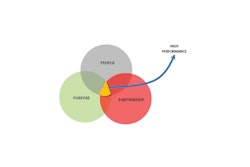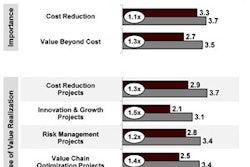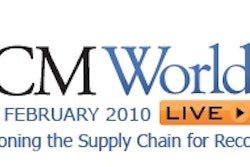
Intergenerational Supply Chain leadership transition is driving great opportunity that can easily be seen as a potential threat, and as such is becoming a key executive concern. This three-part article will explore the what and how of managing this process. We will focus on how to bridge the intergenerational gap and build effective, diverse teams that can co-exist and flourish together in Part 1. Key to creating this culture is to take another look at the primary responsibility of young leaders, experienced subject matter experts which is discussed in part 2 and the role HR plays as a change agent and arbiter, senior leadership’s challenge and required commitment to change will be discussed in Part 3.
A future that already is shaping
It is critical to understand where Supply Chain headed before we understand why managing intergeneration gap is a key concern.
- Social connectivity—Younger leaders typically are more data agile and fluent than their older counterparts. They use social media as a medium to listen to the unfiltered views of the end consumer. These views provide valuable insights that drive rapid product and process innovation. User insights coupled with today’s powerful analytics is key to spotting trends, creating fine segmentation and devising novel supply chain responses & value creation strategies. Social data streams also are having a dramatic effect on talent acquisition by communicating opportunities across a wide audience in very compressed time frames. Your company’s reputation also is in play as social media forums can communicate both positive and negative messages about the culture, practices and health of your firm.
- Expansive, inclusive Supply Chains—While many organizations embrace seamless flow of information within the enterprise, they restrict, delay, adulterate or dumb down information to key value chain partners. This stunts the collaboration potential that could be realized if all constituents had access to “same” information in real time. Transparency and access to information by all partners (suppliers, manufacturers, distributors, etc.) provides a major opportunity for collaboration as a result of end-to-end connectivity.
- Real time visibility & Pervasiveness—Perhaps the most underestimated power of social media, instant access to world events, allows agile Supply Chain practitioners the ability to react to opportunities and threats in real time. Top performing Sourcing and Procurement organizations are particularly plugged to these networks.
- Retiree Friendly Programs—Large well known corporations like IBM, MetLife, P&G, Home Depot and Verizon already have started to implement the new retiree friendly programs and services. Such programs create exciting new opportunities for retirees who want to work, provide value and leverage their skills. Companies are implementing such programs to not only address shrinking knowledge labor pool, but also using to create a learning culture and address developmental needs of young generation.
- Digitization of Supply Chain—Much talked about for more than a decade, digitization of supply chains is coming to life. Thanks to confluence of technology; understanding of supply chain importance and the attraction of talent. We are seeing the increasingly clever use of people, process and technology which behaves like social media popularly referred to as “Systems of Engagement” complementing your ERP. Such technologies are providing real time visibility; rules based proactive management of materials movement; focus on revenues & profits versus cost alone. There is cross-pollination of ideas, philosophy, assets and technology across industries borders that are creating very different looking, agile and hybrid supply chain responses to meet customer demand.
The Widening Chasm….
Future Supply Chain needs a very scientific management approach to Supply Chain and a fundamental shift from today’s Supply Chain management as an “Art.” This will spawn new disciplines, niche skills which will come at a premium and at levels which took an experienced professional a lot of earning stripes. Technology savvy professionals will play a major part of this workforce because of early engagement and fascination to such technology. This is a common scene in Supply Chain and will be amplified with new business realities. Leaders at all levels should pay particular attention to this gap and be sensitive to it.
Mismanaged Intergeneration Gap ….
Mismanaging the process of intergeneration gap impacts the sustainability of corporation in the following ways:
Short term disadvantage: Your process of ideation does not create enough ideas or is not well thought through and always tends to possess a slant to one philosophy, execution or technology. Retaining your top talent possesses an issue and ideation diversity is lost. More time is spent on resolving negative energy and unproductive conflicts versus idea themselves.
Long term disaster: Culturally, your workforce is skewed in thinking, which dampens your business advantage. The competitive edge is lost with culture less focused on operational reality or suffers from living in a bubble of status quo for too long. Organization fails to keep up with Technological advancements and the power to unlock its business potential.
Benefits of managing this process….With the economy being global in nature, every product is subject to a rapid fall towards commoditization. Profit margins are under constant attack, and competition routinely springs up from unforeseen places. A key competitive advantage and long-term defense is your organization's leadership pipeline. Developing the leaders necessary to exploit gaps in the external landscape and build new business models that exploit them profitably is the key to long-term organizational success. Intergeneration gap if managed well creates a robust talent pool. The advantages comes in three folds: hard (business/tangible value), soft (procedural/process-centric), sensitive (people/personal/emotional).
Business: Better idea generation process keeps the business competitive and quickens the value generation process. It converts the organization into innovation centric engine where each success builds rapidly on the other.
Process: Improves the process of going from vision to value, improves business collaboration and thinking win-win abilities. Idea sharing, positive dissention/constructive conflicts helps bring fresh, newer and robust ideas which realizes full promised value. Helps develop solution with right balance of people, process, and technology to drive customer and stakeholder value.
People: Develops leaders to be better influencer managers. Improves their judgment ability and helps young leader to earn their stripes and build credibility within the organization. It also creates appreciation for diverse opinion. Strengthens the leadership pipeline a key advantage for the future with empathetic listening and leadership styles.
Nine common clashes caused by the intergeneration gap:
Reality Check: The optimism of youth versus operational realism of experience
Competence: Objectivity & analytical framework versus subjectivity/intangibles considerations
Solution Bias: Opportunity identification & excitement versus implementation feasibility
Focus area: Technology acceptance as a means to the end versus people and process centric solutions
Thought-ware: Changing the rules of the game versus steadiness & systematic improvement methods
Approach: Socially aware & transparency-centric versus overcautious and guarded thought process
Speed: Impatient about pace of play versus steady or sometimes slow pace of play
Role Mismatch: Role swap with ops leader playing role of technology leader and young leader becoming ops specialist
Problem Solving Capability: Resourceful & unique way to problem solve versus problems solving based on relevant experience
Characteristics of social engine of co-existence
- Culture, Performance Measures and Incentives: As with every philosophy, thinking, initiative it is critical to have a comprehensive look / re-look at the existing culture, players, their performance measures & incentives. Every journey starts with the right cultural set up, role redefinition, set up the of right performance measures. Experienced leaders should be measured on their ability to coach, mentor young leaders into matured future leaders, bring ideas to life & deriving future promised potential. The young leaders should be measured on their ability to collaborate with experienced leaders, influencing and being influenced, ideation process. Incentives should be in place to drive this behavior and monitored.
- Inclusion & Respect: Emphatic listening to all perspective ideas from all levels, providing value to conversation by Socratic style questioning, ensuring that people feel welcome in a dialogue and decision process is key to inclusiveness. To really walk the talk, leaders should deal firmly with people who don’t follow collaboration at all levels? Inclusion also creates powerful ideas which may not been possible otherwise as it creates environment where seemingly simple and non-workable ideas get refined, revised and redefined through positive dissention. Inclusiveness improves the ability to catch issues and potential lapse in thinking that may have otherwise skated through. It builds trust in people that their ideas are heard and will be worked on which improves the ideation process.
- Leveraging strengths: A key skill, if well-developed ensures incredible success. It is critical to know not only your strengths but also the strengths of your team members. Like any good sport, play your role well, occasionally pushing and stretching yourself is key to winning games. Also know what motivates your team members and use it appropriately to get the best of them. One key to note is that no two individuals have same motivation and so your style should adapt. The biggest watch out in a team structure is the issue of role swap where an expert in one area starts playing the role of the other or think they can do others job. So beware of situations like this and approach stretch as a knowledge gaining exercise but not a knowledge mastery demonstration.
- Working Better Together: Understanding the landscape, players, thinking what’s in it for them is key to working better together. Young and experienced leaders should always have a mental working model of what is absolutely critical to effectively think win-win. Beware of over-engineering and practice 95 percent now versus 100 percent never, a key thought to get idea to market quickly without sacrificing quality and service. Personable and approachable style leadership, practicing taking high roads gets more followers, opens doors to work together and creates solutions which are more robust and sometimes considered infeasible.
- Looking at world from someone’s perspective: It is human for people to judge others by their own framework that has been heavily influenced by their generation’s formative events, traits, characteristics and experiences. As a leader, both young and experienced should practice thinking from others perspective and ask the question “how would the other person think & why?” Though extremely difficult practice this by seeing the world from others viewpoint. This is a key leadership trait which helps in all business settings – be it understanding your customers intimately and devising appropriate offerings; envisioning new strategy; cross functional collaboration; inspirational leadership & motivating.
- Shared Vision & Goal: Working on the shared goal is all about putting team and company interests ahead of personal goals. Though seemingly simple, people always tend to forget this simple truth. Be open to taking blame for the team even if it’s not your fault and celebrate the wins together. This builds your reputation as a team player and builds credibility as a selfless leader. Successful implementation creates a domino effect of confidence and produces virtuous cycles of success.
- Two generations in Supply Chain: An experienced hand usually brings history, operational know- how, chronicles of past successes and failures and are important for the survival of the next generation of supply chain. The role of the young leader is to bring new ideas, optimism and fresh, diverse perspective to the process of decision making. We take a more in-depth look at the roles of the two generations in Part II.



















